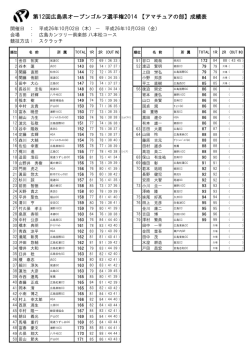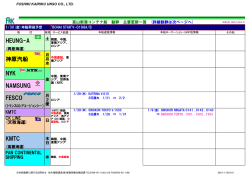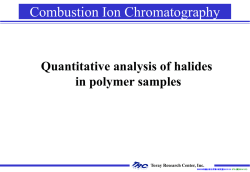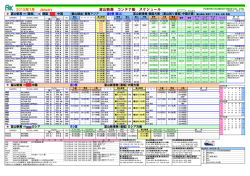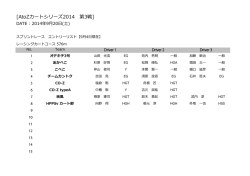
Hayabusa2 Asteroid Sample Return Mission H. Kuninaka JSPEC
Hayabusa2 ! Asteroid Sample Return Mission! ! ! ! ! ! ! ! ! ! ! ! ! !H. Kuninaka! ! ! ! ! ! !JSPEC/JAXA! Mission Outline of Hayabusa-2 Launch June 2018 : Arrival at 1999 JU3 Global observation of the asteroid, deployment of small rover/lander, multiple samplings Dec 2014 Mothership carries an impactor. New Experiment Sample analysis Earth Return Dec. 2020 Dec. 2019 : Departure 2019 The impactor collides to the surface of the asteroid. Further exploration 2 Target Asteroid : 1999 JU3 Rotation period: 0.3178day (~7.6 h) Orbit Itokawa� (λ,β)=(331, 20), (73, -62) Kawakami Model Mueller Model� Axis ratio = 1.3 : 1.1 : 1.0 Size : 0.87 ± 0.03 km Mars Earth Albedo : 0.070 ± 0.006 H=18.82 ± 0.021, G=0.110 ± 0.007 Type : Cg Shape model by Kawakami (by Mueller 3 et. al) イオンエンジン Ion Engine 推進系スラスタ(12基) RCS Thrusters (12) 光学航法カメラ-‐ 望遠、広角 (ONC-‐T, ONC-‐W1) Op6cal Naviga6on Camera-‐Telephoto & Wide) DLR/CNES開発の着陸機 (MASCOT) Lander by DLR ローバ(MINERVA-‐II) Rovers 中間赤外カメラ(TIR) Thermal Infrared Imager 衝突装置 (SCI) Small Carry-‐on Impactor ターゲットマーカ(5基) Target Markers (5) 分離カメラ(DCAM3) Deployable Camera Xバンド高利得アンテナ X Band High Gain Antenna Xバンド低利得アンテナ X Band Low Gain Antenna Xバンド中利得アンテナ 太陽電池パネル X Band Middle Gain Antenna Solar Array Panel Kaバンド高利得アンテナ Ka Band High Gain Antenna スタートラッカ Star Trackers 近赤外分光計(NIRS3) Near Infrared Spectrometer 再突入カプセル Reentry Capsule サンプラホーン Sampler Horn レーザ高度計(LIDAR) Laser Al6meter 光学航法カメラ-‐広角(ONC-‐W2) 6� Op6cal Naviga6on Camera-‐Wide Major Improvements in Hayabusa2� Attitude and Orbit Control System (AOCS) Reaction wheels : 3 à 4 Propulsion System (RCS) Routing of the pipes of the fuel and oxidizer Ion Engine System (IES) Thrust : 8mN à 10mN Neutralizer: Longer life time Target Marker (TM) 3 à 5� 7 Changes of Mission Payloads of Hayabusa2� Optical Navigation Camera (ONC) filter set was changed (ONC-T : 6.35deg^2, ONC-W : 65.24deg^2) Light Detection and Ranging (LIDAR) adapted to low albedo of C-type (Range : 30m – 25km) Near Infrared Spectrometer (NIRS3) absorption by H2O Wave length : 0.85m – 2.10µm à 1.8 – 3.2 µm Thermal Infrared Imager (TIR) – New Thermal radiation Wave length : 8 – 12 µm� 8 Small Lander and Rovers MASCOT� by DLR and CNES� MINERVA-II� MASCOT� -II-2� -II-1� by Tohoku Univ. & MINERVA-II consortium� MINERVA-II-1� MINERVA-II-2� -1A� by JAXA MINERVA-II Team� -1B� 9 New Payloads of Hayabusa2� Ka-HGA X-LGA-A X-HGA High Gain Antenna (HGA) X-band 8GHz Ka-band 32GHz -- New� X-MGA X-LGA-B X-LGA-C SCI Small Carry-on Impactor (SCI) + Deployable Camera (DCAM3) Shape of projectile: Shell type. Deformation process: < 0.5ms Velocity of projectile: > 2000m/s. Weight of formed projectile: > 2kg. Mass of projectile Small Carry-on impactor of HAYABUSA-2 Mission (IAC-11.A3.4.6) DCOM3� Velocity of projectile Observation : by DCOM3 10 Deformation of liner ! ! ! ! Make a small crater on the surface: 2kg cupper liner 2km/s Artificial Crater Generation Operation� separation explosion (a) ①SCI Separation ②Horizontal Escape ③Vertical Escape (b) Impact Observation� Detonation & Impact� 1999 JU3� (a) high speed debris (b) high speed ejecta (c) low speed ejecta (c) U 1999J ④DCAM3 Separation 3� ⑤Detonation & Impact ⑥Return to HP 11 はやぶさ2 2014年打ち上げ、2018年着、2020年帰還� Hayabusa2 Mission Schedule year 2014 month � � 12 Spacecraft� Launch windows� 2015 2016 2017 2018 06 06 12 2019 08 2020 12 12 IES operation� Earth Swing-by Arrival at Science 1999JU3� observation, Sampling� Departure from 1999 JU3� Earth return� IES operation� Impactor� 23
© Copyright 2026
